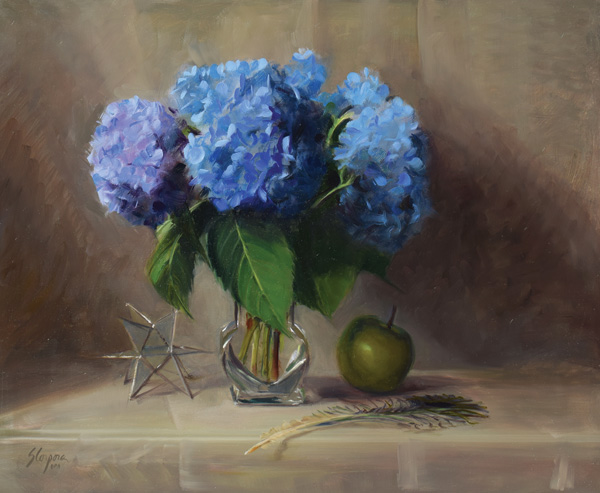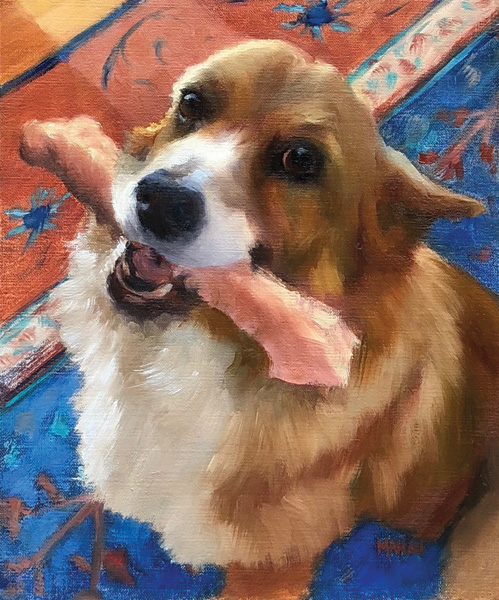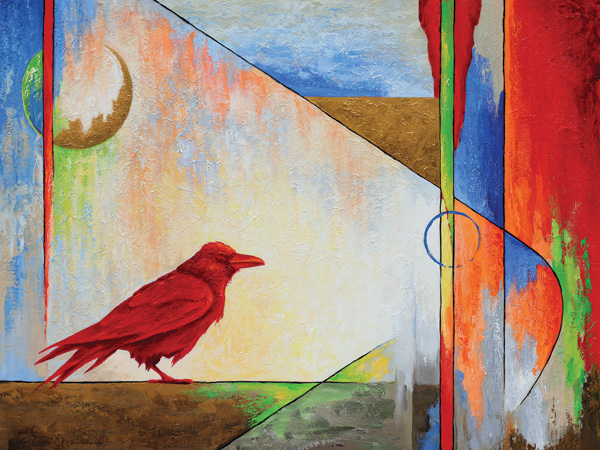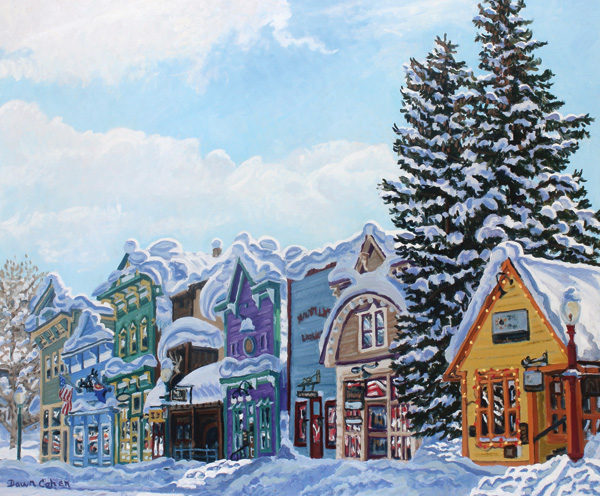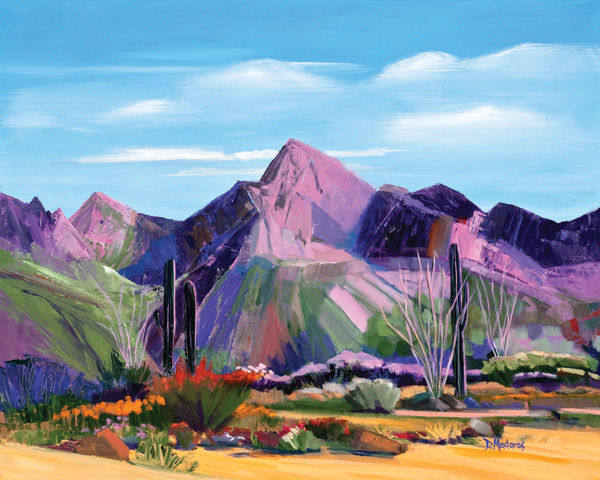Meet 12 women who are making their marks
This story was featured in the October 2018 issue of Southwest Art magazine. Get the Southwest Art October 2018 print issue or digital download now–then subscribe to Southwest Art and never miss another story.
Sandra Corpora
- Sandra Corpora, Star Blue Hydrangea, oil, 18 x 22.
Sandra Corpora has been creating art since she was a young girl growing up in Pennsylvania, where she still lives and works today. “I’ve always had a strong connection to the natural world around me,” she says. “I remember when I was 9 years old, I had a set of oil paints, and for some reason I felt very compelled to take them outside and paint the white-pine tree next door. It was my very first plein-air painting.”
Since then, Corpora has gone on to study and paint a variety of subjects and styles. But whether it’s still life or landscapes or figures, she has always been attracted to painting from life. “It is such a powerful feeling to draw from life,” she says. In fact, the artist finds herself enamored with all forms of life around her, be it the change of the seasons in the natural world or the seasons of change that show up in the faces of people as they move through life.
Corpora hopes the viewer will get a sense of her own excitement when they look at her work. “My paintings attempt to capture the essence of a place and time and the beauty I see around me,” she says. “The way the light falls to create a pattern of values and colors is often the thing that inspires me. It can be a person’s face, objects in a still life, or the landscape softened by the atmosphere. Inspiration is everywhere.” Find her work at Gross McCleaf Gallery, Philadelphia, PA, and Sandra Corpora Studio, Bethlehem, PA. —Lindsay Mitchell
Diane Arenberg
- Diane Arenberg, Sonoran Morn, pastel, 30 x 30.
Growing up in the Midwest, Diane Arenberg was constantly expressing herself through art. She went on to study and work in art therapy, interior design, and fine art. But amidst all her artistic pursuits, there’s one experience that had perhaps the most profound impact on her life and work: About 30 years ago, she went on a painting trip to Ghost Ranch, Georgia O’Keeffe’s onetime home in northern New Mexico. As soon as she arrived, Arenberg says, “There was something in my whole being that just felt like I was home.”
That trip ignited both her love of the southwestern landscape and her passion for painting. In 2009 she finally moved “home” to Santa Fe, where she continues to create art full time. She also sits on the board of directors and teaches a plein-air painting workshop at Ghost Ranch—her way of “giving back” to her inspirations and passions in life.
While landscape painting is a primary focus of her art, Arenberg creates works in a wide variety of mediums, including jewelry and monotype prints. “Working in different mediums, for me, is like speaking different languages,” she explains. “Art enables me to express feelings that cannot be said with words.”
Whatever the medium, the artist’s love for nature and the elements of color, light, texture, and form shine through. “Whether I’m looking at the grandeur of the landscape, a gemstone, or ink as it is spread across a printing plate, I strive to incorporate my fascination with these phenomena in my work,” she says. Find Arenberg’s work at www.dianearenberg.com. —Lindsay Mitchell
Rox Corbett
- Rox Corbett, When Prairie Dogs Dream III, charcoal, 10 x 8.
For many years, Rox Corbett has touched the emotions of viewers across the country with her detailed charcoal drawings of animals. Exhibiting annually in large western shows such as Cowgirl Up! and Western Visions, she continues to find new sources of inspiration in animals both domestic and wild.
Corbett lives on a ranch near Cody, WY, with an assortment of animals. While horses and their cowboy handlers dominate her portfolio, the artist also observes the wild bears, foxes, and deer that roam near her property. “I’ve got to keep changing it up, otherwise I’ll go nuts and lose my enthusiasm,” she says. Recently, Corbett began a series of paintings focused on prairie dogs and their predators. “The prairie dog has so many different predators, and he’s just sitting on his burrow like a little Buddha, unconscious of what is coming to eat him,” she says. The artist also began painting Navajo Churro sheep, whose unique wool is used to make traditional Navajo rugs. Corbett hopes to continue expanding her reach by drawing more landscapes and marine life in the future.
Whatever her subject, she remains loyal to her black-and-white medium. “It has this simplicity that allows you to concentrate more on shape and texture without the distraction of color,” she says. Corbett hopes her work inspires empathetic feelings in others for the animals she loves. Her work can be seen at Big Horn Galleries, Cody, WY, and Tubac, AZ, and www.roxcorbettart.com. —Mackenzie McCreary
Deb Komitor
- Deb Komitor, Serenity in Motion, oil, 34 x 24.
Deb Komitor has always felt a kinship with trees. Growing up in the Midwest, she could often be found drawing and exploring in the woods and forests. Today the artist makes her home in Colorado Springs, CO, where she continues to explore the stunning natural environment around her that inspires her large-scale studio paintings of aspens and other trees.
The increase in the number of devastating forest fires in recent years has added a feeling of urgency to her work. “So often, when you look at trees and old forests, you think of them as such strong, almost permanent features of the landscape,” she says. But after wildfires hit Colorado in recent years, she began to realize even more just how precious and impermanent everything is. “I really felt the need to paint what I think of as portraits of trees—to commemorate, so to speak, the individual beauty and life of each one,” she says.
Komitor’s style and process speak to her unique approach to her work overall. She begins each piece on black-gessoed canvas; then, using vibrant colors and geometric, almost pixellike brush strokes, she feels as though she is “drawing out the light from the darkness” of the canvas.
Indeed, this is not just a great metaphor for her art, but for her worldview as well. Her aim is to demonstrate the beautiful balance of “exuberance and calmness, groundedness and flexibility, strength and lighthearted joy” that she sees all around her. Find Komitor’s work at Abend Gallery, Denver, CO; Raitman Art Galleries, Vail and Breckenridge, CO; Taos Blue, Taos, NM; and Colorado Springs Fine Arts Center Museum Shop, Colorado Springs, CO. —Lindsay Mitchell
Johanne Mangi
- Johanne Mangi, The Woodster, oil, 12 x 9.
It’s easy for painter Johanne Mangi to fall in love with her subjects. Whether it’s the smooth coat of a yellow Lab or the scruffy ears of a terrier, the dogs she paints always find their way into her heart. But the artist also has a greater goal. “These kinds of portraits have never been viewed as serious art,” Mangi says. “This is my passion, and I want to elevate these to the same level as other portraits.”
While Mangi was interested in art throughout her youth, she was discouraged by the trend of abstract expressionism taking over art schools in the early 1970s. Years later she began taking classes and studied under Richard Schmid and the Putney Painters. “I don’t dabble in things, I immerse myself in them,” she says. “I was blown away [by their work], and I knew this was what I wanted to do.” But she didn’t settle on the subject of animals until her mentors, painters Sherrie McGraw and Kathy Anderson, helped her gain commissions for portraits of dogs.
Mangi works from both photos and live animals. “I’m not afraid that they’re always moving because I’ve gotten so good at reading them and understanding their little quirks,” she says. The artist says she considers her work an honorable challenge. “I want viewers to feel that I’ve captured the dog—not just what it looks like, but what’s thriving about it,” she says. “I want them to feel the soul that’s in the painting.” Mangi’s work can be seen at West Wind Fine Art, Colorado Springs, CO, and www.johannemangi.com. —Mackenzie McCreary
Lorraine Sack
- Lorraine Sack, Soaring, oil, 30 x 30.
As a child growing up in rural Minnesota, Lorraine Sack would listen raptly as her mother pointed out the unique features and behaviors of different birds around their home. “I was pretty intrigued,” says Sack. “Birds mark the seasons for us, whether through migration or nesting or springtime, and they touch on so many aspects of our lives, from omens to hope to happiness.” Plus, she adds, “They are so magical and fanciful. What else flies that has so much color?”
Today the Tucson, AZ, artist routinely portrays birds in her figurative and still-life paintings as she explores both lighthearted and serious narratives inspired by her feathered muses. Sometimes the bright plumes of a parrot might spark an idea. Other times, says Sack, “It’s a phrase or a quote I’ve come across, and I’ll ask myself what bird fits it.”
As a classically trained artist, Sack works in the realist style, but she takes an imaginative approach when depicting her subject matter. To create background scenery, for example, she likes to set up a magnetic chalkboard featuring her own whimsical drawings of birds, landscapes, Art Nouveau designs, and other colorful imagery. She even attaches tangible objects to the board using magnets, sometimes draping fabric over a corner. “It’s a lot like theater,” says the artist. “I love the magic you can create with illusions.”
Another hallmark of Sack’s work is her penchant for combining her two favorite genres, which allows her to build upon color harmony, depth, movement, and narrative as she pairs her models with carefully planned still-life arrangements. “It’s always a puzzle, and I like that part of creating very, very much,” she says. Find Sack’s work at www.lorrainestudios.com. —Kim Agricola
Lexi Sundell
- Lexi Sundell, Red Raven Light, acrylic, 36 x 48.
For Lexi Sundell, becoming an artist was “practically unavoidable,” she says. She comes from a large family of artists and even ended up marrying one. Since she was very young, Sundell has been creating everything from jewelry to photography to paintings. Eventually she and her husband opened RiverStone Gallery in Ennis, MT, where they often spend their spare time fly-fishing on the great trout waters of the area. Sundell also grows thousands of poppies and other flowers each year in her unruly and extensive gardens.
While her earlier paintings were primarily of flowers, in recent years she has developed her own style of big, colorful, abstracted works created with alternating layers of gel and paint that often feature large wild animals such as bears, buffalo, horses, and big cats. “I am having a blast experimenting with color, values, light and dark hues, and contrast,” she says happily.
Yet Sundell has also experienced great tragedy in her life, and it was during those difficult times that art had the most profound impact on her. “For me, the creative process has made the difference between living and dying,” she says. The transformative nature of creativity is ultimately what Sundell hopes to convey in her work, no matter the subject or medium. “I truly believe in the power of art to transform our lives,” she says, “and I want to share my own transformation with the viewer—to express the joy and exuberance of being that I know can spring out of even the most awful circumstances in life.” Find her work at Creighton Block Gallery, Big Sky, MT; Wild Holly Gallery, Carefree, AZ; and RiverStone Gallery, Ennis, MT. —Lindsay Mitchell
Dawn Cohen
- Dawn Cohen, Mountain Town Sprawl, oil, 30 x 36.
For painter Dawn Cohen, it’s not necessarily a particular subject that most inspires her, but rather the element of contrast—be it contrast of light, color, or between people and man-made objects in nature. Since graduating with her master’s degree in fine art from Colorado State University, the Georgia-raised and Crested Butte-based artist has been creating plein-air works depicting landscapes, seascapes, flowers, buildings, and other subjects.
One of the most surprising aspects of her works is their sizes—all quite large for plein-air paintings, a result of her refusal to “give” on either her passion for painting on large canvases or her passion for painting outdoors. “I pride myself on making large-scale paintings, where I return to the same painting spot day after day until it is complete,” she says. Most paintings take about three to four weeks for her to complete. And while this approach comes with challenges, like constantly changing light and braving the elements, it also has benefits that bring unique perspective to her work. “I love how working outside day after day is so much more involved,” she says, explaining that her process allows her to do a more complete investigation of a scene—to observe different aspects of light, shadow, and values over time—which she can then incorporate into a truly unique painting.
No matter what the subject, place, or season, Cohen always revels in her work outdoors. “I believe in the power of observation—it’s the connective tissue in everything I create,” she says. Find her work at Shaun Horne Gallery, Crested Butte, CO; Reynolds Square Fine Art Gallery, Savannah, GA; Turquoise Door Gallery, Telluride, CO; and www.dawncohenfineart.com. —Lindsay Mitchell
Lee Mitchelson
- Lee Mitchelson, Wildflower Meadow, oil, 8 x 10.
When Lee Mitchelson contemplates her earliest memories, her interactions with people don’t stand out. She does, however, vividly remember her dog, Mike, and the two amiable border-patrol horses that would periodically poke their heads into her open bedroom window, “nickering” her awake, at her childhood home in Chula Vista, CA, near the Mexico border. “This seemed reasonable, and perfect, to me,” says Mitchelson, who now resides in Arizona. “I did not view animals as lesser beings, but only as different than us, with their own emotions and perceptions.”
Not surprisingly, by age 5, the budding artist was drawing animals. Her uncle, an instructor at the Herron School of Art, mentored Mitchelson throughout her childhood, and later, she studied fine art for a spell at Pasadena City College. After starting a family, she painted mostly commissioned portraits of pets and people in her spare time. Once her kids were grown, she began painting with other artists she admired, including her friend, California Impressionist Karl Albert (1911-2007).
Today Mitchelson toggles between impressionism (when painting for her own satisfaction) and realism (when completing commissioned and gallery pieces), but her compassion for animals always guides her brush. Her subjects range from wildlife and their habitats to domesticated horses and canines, and inspiration is never far from view: The artist runs a refuge for primarily older, special-needs animals called Star View Lifetime Sanctuary. Portraying animals living peacefully, in safe environments, is always Mitchelson’s goal. “I do not have any desire to paint stressful scenarios involving animals,” she says. “I am far too empathetic to what animals experience to be able to do that.” Mitchelson is a member of Oil Painters of America. Find her work at Goldenstein Gallery, Sedona, AZ, and www.leemitchelsonart.com. —Kim Agricola
Lois Griffel
- Lois Griffel, Desert Texture, oil, 22 x 28.
One of the things Lois Griffel appreciates most about painting en plein air is that, from day to day, no two paintings of the same view ever look alike. “You can portray one subject in many different light conditions, and they will all be different,” says the artist. Adding to that diversity are varied regional treasures that catch Griffel’s eye, from Florida’s marshes at the break of dawn to the Santa Rita Mountains burnished pink at sunset—a view she enjoys from her own patio in Green Valley, AZ. “It’s really the light that inspires me,” she says.
As a young artist, Griffel studied portraiture at the Art Students League in New York. There, she learned the tenets of classical painting that she still practices today in a style she describes as classical impressionism. For many summers, she also worked as a sketch artist in Provincetown, MA, before moving there in 1975 to study with artist Henry Hensche (1899-1992). Hensche’s impressionistic use of color propelled Griffel into a new way of viewing, and capturing, the world around her. “The reality is that color is our subject—not the trees, not the pretty flowers,” she explains. “Impressionism is about seeing the variety of color in the atmosphere.”
Having lived in Massachusetts for four decades—18 years of which she spent serving as the director of the Cape Cod School of Art—Griffel is relishing the “starkly different” beauty of Arizona, her home now for 13 years. “Every day is unique, and every light effect is unique,” she says. Find the artist’s work at Gallery Antonia, Chatham, MA; Hughes Gallery, Boca Grande, FL; Zforrest Gallery, Tubac, AZ; Art Under the Arches, Ajo, AZ; and www.loisgriffel.com. —Kim Agricola
Diana Madaras
- Diana Madaras, Pink Ocotillo at Pusch Rige, acrylic, 24 x 30.
Diana Madaras’ love for the wild is palpable in each of her paintings. Her desert scenes pop with a kaleidoscope of colors assigned to each petal of a cactus and edge of a mountainside. In the midst of it all, wild creatures come out to play.
Madaras is always searching for new ways of painting. She describes herself as a colorist and works in several mediums including acrylics, watercolors, and mixed media. “I like to push the envelope,” she says. “I have that flexibility, so I am always experimenting.” The artist is deeply inspired by the work of recently deceased artist John Nieto. Madaras represented Nieto’s work for many years in her namesake gallery, which has been voted the best gallery in Tucson, AZ, by readers of the Arizona Daily Star.
While Madaras floats easily between subjects including landscapes and florals, the artist’s deepest connection is with animals. She grew up helping to care for the animals in her father’s veterinary practice, and over the years, sales of her work have benefited more than 100 local animal charities through her nonprofit organization, the Art for Animals Foundation. An upcoming show features her most recent series, titled Spirit Animal, which combines the artist’s spiritual connection to animals with her continued love of experimentation. “My mantra is color in joy,” she says. “When someone connects with my painting and it brings them happiness, I know I’m doing my job.” Madaras’ work can be found at Madaras Gallery, Tucson, AZ, and www.madaras.com. —Mackenzie McCreary
Lucy Yanagida
- Lucy Yanagida, Dorn Barn, oil, 9 x 12.
Colorado artist Lucy Yanagida has always loved creating art. While painting wasn’t always a primary focus in her life, there was a constant voice in the back of her head that continued to call her to art. “The older I got, the louder that voice grew, and I knew I should follow it,” Yanagida says.
Six years ago, she finally gave in, and she’s been pursuing her passion for painting the landscapes and wildlife of the West ever since. “Growing up in Louisiana, I had horses and other animals, and I was always playing outside,” she says. “Being around nature and wildlife is just so good for the soul.”
Today the artist continues to hone her craft, painting plein-air and studio works in oil and, more recently, pastel. “I’ve learned so much from workshops and classes with renowned artists like wildlife painter Edward Aldrich of Golden, CO,” she says. She also learns from her own experiences in nature, often setting out in the early morning hours to explore the Colorado wilderness with her teenage son, who helps her take photographs of the stunning scenery they encounter.
While it took her several decades to fully pursue her true passion for painting, Yanagida is full of gratitude, not regret. “I really think this was God-given to me, learning to paint and sharing his world in this way,” she says. “It’s almost physically uncomfortable to imagine this love of art going to waste and never sharing that with others.” Fortunately, that’s not a reality the artist or her collectors will have to face any time soon. See the artist’s work at Framed Image, Denver, CO, and Lucy Yanagida Studio, Superior, CO. —Lindsay Mitchell
This story was featured in the October 2018 issue of Southwest Art magazine. Get the Southwest Art October 2018 print issue or digital download now–then subscribe to Southwest Art and never miss another story.
MORE RESOURCES FOR ART COLLECTORS & ENTHUSIASTS
• Subscribe to Southwest Art magazine
• Learn how to paint & how to draw with downloads, books, videos & more from North Light Shop
• Sign up for your Southwest Art email newsletter & download a FREE ebook






